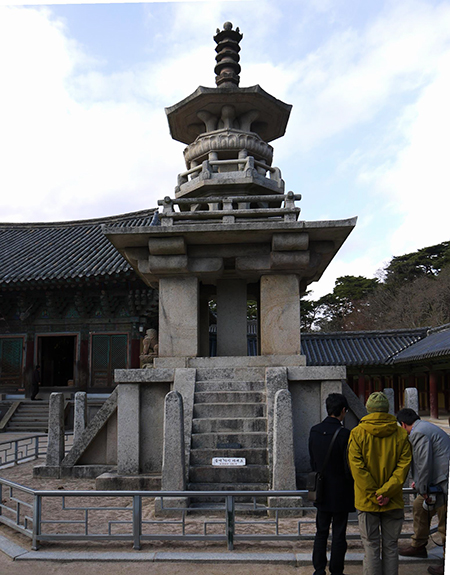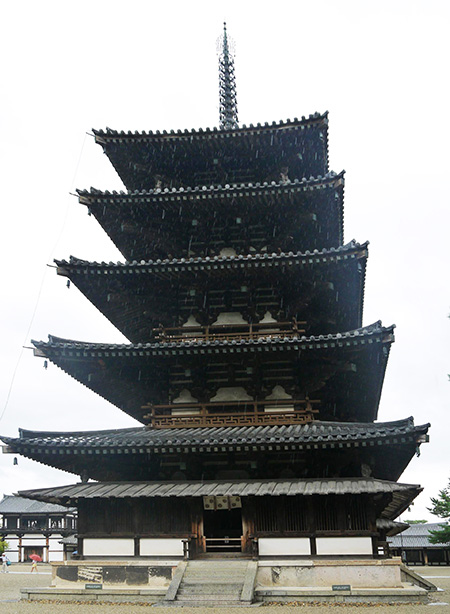

寺院建築って修学旅行で法隆寺とか見学するけれど、
ああいうのは鎮護国家思想以来の日本教育の定番なのでしょうか。
まぁ若いときには夜の枕投げが楽しみ(笑)で、見学時はほぼボーッとしている。
建築教育的にはたいへんもったいない極みだと思うのですが、
それでも若いときに上の空でも訪問体験を持つというのはなにがしか、
リスペクトできる民族文化を体験するという意味でいいことですね。
たまたま法隆寺と同時代の韓国の対照的な仏国寺も体験して
両方に共通するもの、そうでないものを見る機会を得て興味が深まった。
東アジア世界での仏教思想の拡散という事態は、
今日で言えば資本主義と民主主義みたいに律令主義とワンセットだったと思える。
この時代での最先端の「国際主義」の象徴であり、
だからこそ奈良東大寺大仏開眼会には遠くインドからも国際使節団が来朝した。
韓国社会からも新羅の王子を首席とする祝賀訪問があった。
日本ではこの鎮護国家思想は同時に統一国家体制の確立でもあった。
鍍金された黄金仏の様子が後代のマルコポーロ・東方見聞録に記事反映され
ヨーロッパ世界の大航海時代突入を導いたともいえる。
法隆寺は創建からながく日本社会の精神的基軸として人々の拠り所となったが、
一方で韓国仏国寺ではそのようではなく廃寺状態が永かったとされる。
韓国・朝鮮では大陸国家中国と陸続きの半島国家なので、
政治争乱で仏教はそのときどきの独裁国家から迫害されることも多く、
その情勢変化に敏感に反応せざるを得ずに迷走があったのでしょう。
むしろ仏教よりも儒教の方が「国教」ともいえる存在だった。
日本における法隆寺のような国家社会的なシンボル性は持ち得なかった。
世界的にはこの二つの寺院建築は世界遺産とされているけれど、
国民統合のひとつの象徴とまでされてきた法隆寺の独自性が際だつ。
仏教の教えにおける「塔」というものの役割について
この仏国寺多宝塔と、法隆寺五重塔は意味合いとしては似ているそうです。
寺院建築の「伽藍配置」にとって決定的な意味合いを持っていたことはわかる。
キリスト教世界での十字架を乗せた塔と似た象徴性がある。
五重塔に対してほかの建築群とは隔絶した象徴性を日本人は感じている。
仏国寺の石造りの多宝塔も創建時以来、焼失などの危機からも生き延びている。
きわめて重要な国宝とされてきています。
日本社会ではこうした建築が木造で建てられたことで、
大工技術職の永続的な存続が可能になってきたとも言われる。
各地の寺院でのお抱え大工職・宮大工の地位について
歴世、裁判にまでなっている事実があるのですね。
大工技術職というのは大組織化は難しいものであって基本は徒弟的伝承。
だから不安定なその時々の建築需要対応だけでは永続が難しかったのでしょう。
宮大工職が技術伝承にとっても貴重だったのだとわかります。
韓国・朝鮮で仏教寺院が社会的にも衰退を繰り返したと言うことから
木造建築技術伝承も危機にさらされてきたということなのでしょう。
English version⬇
[Stone Tahoto and Wooden Five-storied Pagoda Horyuji Temple and Bulguksa Temple-2]
I visit Horyuji Temple on a school trip for temple architecture,
Is that the standard of Japanese education since the chingo kokka idea?
Well, when I was young, I was looking forward to throwing pillow fights at night (laughs), and when I visited, I was almost dumb.
I think it’s a great waste in terms of architectural education,
Still, it ’s kind of like having a visit experience even in the sky when you ’re young.
It’s good in terms of experiencing a respectable ethnic culture.
I happened to experience the contrasting Bulguksa temple in Korea, which was the same period as Horyuji.
I got the opportunity to see what is common to both and what is not, and I became more interested in it.
The spread of Buddhist thought in the East Asian world
Today, I think it was a set with ritualism like capitalism and democracy.
It is a symbol of cutting-edge “internationalism” in this era,
That is why an international delegation from India came to the morning at the Todaiji Daibutsu Opening Party in Nara.
There was also a celebration visit from Korean society with the Prince of Silla as the chief.
In Japan, this idea of a state of protection was also the establishment of a unified national system.
The appearance of the plated golden Buddha is reflected in the article of the later Marco Polo, The Travels of Marco Polo.
It can be said that it led to the entry into the Age of Discovery in the European world.
Horyuji Temple has been a base for people as a spiritual axis of Japanese society since its foundation.
On the other hand, at Bulguksa Temple in Korea, it is said that the temple was abandoned for a long time.
In South Korea, it is a peninsula nation connected to the continental nation China, so
Buddhism is often persecuted by dictatorships from time to time due to political conflicts,
Perhaps there was a stray because he had to react sensitively to the changes in the situation.
Rather, Confucianism was more of a “state religion” than Buddhism.
It could not have the national social symbolism of Horyuji Temple in Japan.
Although these two temple buildings are regarded as World Heritage Sites worldwide,
The uniqueness of Horyuji Temple, which has been regarded as a symbol of national integration, stands out.
About the role of the “tower” in Buddhist teaching
The Bulguksa Temple Tahoto and the Horyuji Five-storied Pagoda are similar in meaning.
It can be seen that it had a decisive meaning for the “cathedral arrangement” of temple architecture.
It has a symbolism similar to that of a tower with a cross in Christendom.
The Japanese feel that the five-storied pagoda is a symbol that is isolated from other buildings.
The stone Tahoto of Bulguksa Temple has survived the crisis such as burning since its foundation.
It has been regarded as an extremely important national treasure.
In Japanese society, these buildings were built with wooden structures,
It is also said that the permanent survival of carpentry engineers has become possible.
About the status of carpenters and palace carpenters in various temples
There is a fact that it has been tried in the past.
It is difficult for a carpenter to organize a large organization, and the basics are apprenticeship.
Therefore, it would have been difficult to perpetuate just by responding to the unstable construction demand at that time.
You can see that the Miya carpenter was also valuable for the transfer of technology.
From the fact that Buddhist temples have repeatedly declined socially in South Korea
It seems that the tradition of wooden construction technology has also been in jeopardy.
Posted on 9月 14th, 2021 by 三木 奎吾
Filed under: 住宅マーケティング, 日本社会・文化研究







コメントを投稿
「※誹謗中傷や、悪意のある書き込み、営利目的などのコメントを防ぐために、投稿された全てのコメントは一時的に保留されますのでご了承ください。」
You must be logged in to post a comment.